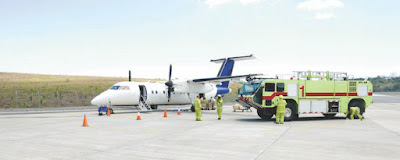NFPA 409, Standard on Aircraft Hangars defines hangar group classifications, construction features, and fire protection requirements for aircraft hangars. Group I and II hangars require foam and foam-water type systems. The design the criteria for these is referenced in NFPA 409, Chapter 6. Determining the correct system design is essential to proper functioning of these systems. In, Design of Special Hazard and Fire Alarm Systems, Robert Gagnon outlines a 12 step design method for aircraft hangar protection.
Step 1. Determine aircraft hangar group and select protection system type.
Each hangar group permits only specific types of fire protection systems designs. These options can include a foam-water deluge system, with underwing supplementary protection, automatic sprinkler with low-level foam, low-level high expansion foam, or a closed-head foam water system.
See also, Guide to Hangar Classifications.
Step 2. Determine foam application time.
These times can vary based on the hangar group classification and foam systems utilized.
- Low-expansion foam - 10 minute application time
- High-expansion foam - 12 minute application time
- Foam-water hand hose stations - 20 minute application time
Step 3. Determine system design density.
This will be based on the system coverage area, sprinkler spacing, type of foam used, and design density as outlined in the various component sections of NFPA 409:6.2.
Step 4. Estimate protection discharge rate.
Use the formula:
D = (A) x (R)
D = foam solutions discharge rate, gpm
A= hangar floor area, square feet
R= application rate (from Step 3), gpm per square foot
Step 5. Estimate concentrate quantity for protection.
Use the formula:
Q = (A) x (R) x (T) x (%)
Q= foam concentrate quantity, gallons
T= foam discharge time
% = concentrate percentage, decimal
Step 6. Determine aircraft wing area.
Hangars that house aircraft having a wing area in excess of 3,000 sq.ft. are required to have supplementary under-wing protection. Without this under-wing protection the low-expansion foam system may be blocked from accessing the fire. The most common and effective supplementary under-wing protection is the use of oscillating monitors.
Step 7. Determine under-wing oscillating monitor location.
These should be located perpendicular to the fuselage to provide unobstructed protection beneath the wings.
Step 8. Determine oscillating monitor coverage area.
Monitors by different manufacturers will throw water in a certain radius and distance. When the radius is obtained the area of monitor coverage must be determined. To determine coverage area use the following formula:
Monitor area = [(3.1416) x (r2)] x (area of coverage/360)
Step 9. Apply oscillating monitor discharge time and application rate.
Discharge time is 10 minutes. Application rate is 0.10 gpm per square foot.
Step 10. Determine oscillating monitor discharge rate and concentrate quantity.
Use the formula:
D = (A) x (R) x (N)
Q = (A) x (R) x (N) x (T) x (%)
N = number of monitors installed
Step 11. Determine supplementary hose discharge requirements.
A minimum of (2) hose lines at 60 gpm each for 20 minutes is required.
Step 12. Determine hose discharge rate and concentrate requirement.
Use the formula:
D = (N) x (R)
Q = (N) x (R) x (T) x (%)
Related posts:
- High-Cost of a Hangar System Discharge
- NFPA and Aircraft Hangars
- Aircraft Facility Fire Codes Index
- Fire Pumps for Aviation Facilities
- Fire Safe Hangar Space [FREE COURSE]
- Fire Protection for Control Towers
- NFPA 409 - Understanding Aircraft Hangar Fire Protection and Maintenance Requirements
 |
| Now booking for 2017-2018. Contact, thecodecoach@gmail.com for more information. |








